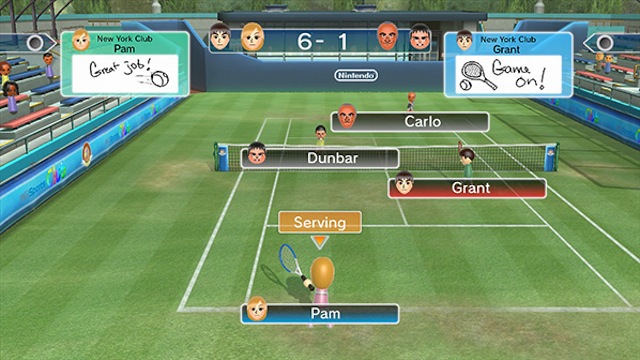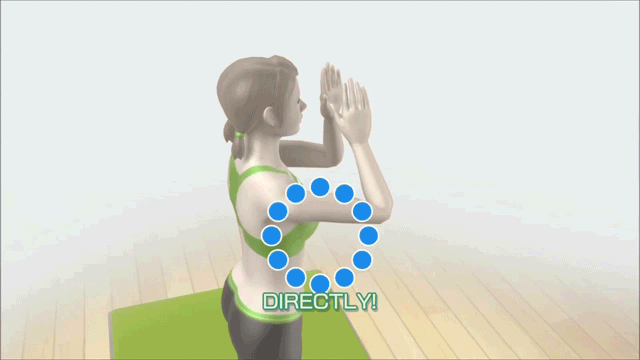Last week, Nintendo revealed how two of their biggest Wii franchises, Wii Fit U and Wii Sports, would be returning on Wii U. They are both arriving on the Wii U in very unusual ways. And there’s one very telling catch. Let’s go glass half-full on this one, shall we?
Wii Sports is coming back as a series of HD re-makes, one or two sports at a time, each upgraded from their presentation in the 2006 Wii launch game with the addition of online play. The first two sports, tennis and bowling, will be released on November 7 for download, with boxing, baseball and golf to follow.
Each sport can be bought for $US9.99, meaning that the whole thing will eventually be purchasable for $US49.95.
You can buy one of them, five of them or — this is the most creative part of it — none of them and simply spend $US1.99 on any day that you want to play them. You’ll have access for 24 hours. This is, as far as I know, the first time Nintendo has ever offered their games for what amounts to a $US2 rental. Insanity? We’re being positive here. Let’s call it inspired.
While some pundits might find it tempting to dismiss Nintendo as being out of step with the times, here we see price experimentation that feels incredibly modern. What’s next, offering the next Zelda for a $US2 rental? Probably not, but why — just brainstorming — shouldn’t the next Mario Kart include an offer like this? What kind of appeal might a Nintendo console have if it supported rentals of lots of popular multiplayer games?

Let’s also talk about Wii Fit U, because that’s where it gets even more interesting and weird. The game is “free” for its first three months to anyone who has a Wii U and a Balance Board (those cost money). It’ll remain free for a month and stay “free” longer if you buy a $US20 Wii Fit Meter (a pedometer with extra features).
It would be one thing if the decision-makers at Nintendo were going the way of so many iPhone game-makers and offering Wii Fit U as free-to-play forever. They’re not. They are clearly in a position where they need to sell most potential Wii Fit U users a $US300 Wii U in the first place. They need to convince people to spend money, just not as much money as they would if they were selling Wii Fit U for full price. Notice that their whole pitch, by the way, involves the assumption that their customer has a Balance Board. There are likely to be millions of people who have Balance Boards collecting dust somewhere. Nintendo is trying to give them a reason to fork over $US300 and dust them off.
Nintendo is getting experimental here. Nintendo getting experimental with how they value and sell their games is a fascinating thing.
Ah, but let’s get to this very important, very telling part of the video announcement that accompanied all of this news. You’ll want to go to the 14:25 mark:
What you’ve got there is Nintendo of America president Reggie Fils-Aime saying that “If you have a basic Wii U model or your system is short on space, you want to get an external storage device before downloading Wii Fit U.”
In blunter terms, he’s acknowledging that the file size for Wii Fit U is too large to be downloaded on the original “basic” model of the Wii U, which has 8GB of storage compared to the “deluxe” and now-default model that has 32GB.
I feel the need to rephrase and bold this: In 2012, Nintendo released a “basic” version of their new console that is, out of the box, incompatible with Nintendo’s 2013 plan for releasing the sequel to arguably the most successful game on their most successful console ever.
It is hard to imagine that the Nintendo of 2012 foresaw what the Nintendo of 2013 was going to do. If they did, that is one bizarre strategy. But, since we’re being positive here, let’s instead assume the company is rapidly re-thinking how it produces and provides games. It is reacting to changing times and showing that it can be flexible. It is dabbling with the very idea of how people should get access to their games.
I recently interviewed Fils-Aime and asked him about the Wii U’s fairly small storage capacity. He defended the party line, saying that Nintendo’s support for expandable external storage devices was plenty consumer-friendly. He seemed unmoved by my observation that Nintendo’s peers already offer much larger drives in their current consoles and plan to offer 500GB drives in their November-launching new machines.
So be it.
Nintendo is, to some extent, stuck with the hardware they shipped in 2012, even if the way they sell their games has moved forward.
A year ago, Nintendo was only just beginning to follow Sony’s example of offering its portable games day and date for download and in stores. A year ago, Nintendo was about to launch a console with 8GB of flash memory.
A year later, Nintendo is suddenly emphasising the downloading of its games with nothing less than its flagship Wii titles for its new Wii U console. A year later, Nintendo is experimenting radically with how much it charges for games.
Some may see a Nintendo that’s in stasis or that is sliding behind the innovation of others. Perhaps what we’re really seeing is Nintendo taking some significant swings and trying to give their tanker of a company some speedboat-style turns. I’m not sure where they’ll wind up a year from now. I’m not sure how they’ll be selling their games. But with this much change and churn, it’s sure to be interesting.

Comments
13 responses to “Let’s Analyse Last Week’s Weirdest Nintendo News In A Positive Way”
What I got away from it is the Wii Fit Trainers green costume for Smash Bros.
They would have several colours as alternate costumes anyway. Likely blue, red yellow, green and some others…
Yes, but now we know the all important shade of green.
All I thought about after reading this was how good a HD snow boarding balance board game would be.
Oh man…..bring THAT shit on!!!
“Our bodies are sufficiently ready”… For all that wii fit trainer r34. OHGODWHY?!
Our bodies weren’t ready enough I’m afraid, the internet just works too fast.It’s existed ever since she was announced as a character for Super Smash.
$2 rentals is kind of genius. I remember hiring games as a kid when I had friends over, often the multi-player games you might not play much otherwise, you could always find a few bucks to hire them. I love that most of all it feels like Nintendo just want people to play their games and money is seondary.
Is that end part about the Basic model Wii U a bit weird to anyone else? I mean I just wanted the black one, if the colours were reversed I probably would have got the smaller one anyway because I only really need the storage space for save files. But the 4GB model of the 360 is in exactly the same position, if you want more space then bring your own external storage… what’s wrong with options?
If anything the 360 is worse cuz you’re limited to 32GB external vs Nintendo’s uncapped amount
I think it’s more to do with market positioning. The Basic model was originally targeted at “soccer mums” and the like who bought a Wii for Wii Sports, Wii Fit and (maybe) Wii Sports Resort. The Premium (or whatever it’s called) model was targeted at Nintendo’s faithful, and other lifestyle gamers (i.e. people for whom games form a significant part of their lifestyle).
Wii Fit U and Wii Sports U are targeted at the first group of gamers, not the second – so there’s a mismatch between hardware capabilities and software requirements.
I would imagine that the first group of gamers would be the ones who would just go and grab the game from a store, probably not even bothering to connect their Wii U online let alone download a game. Which was kind of the idea behind the lack of internal storage anyway, in which case it’s not really an issue.
How is this in any way not good?
I like the cheap model of the Kinect sports games that are approx. AU $2.99 each. They’re fun for a short time but at least you keep them. It’s good that these companies are trying new pricing models for the consoles.